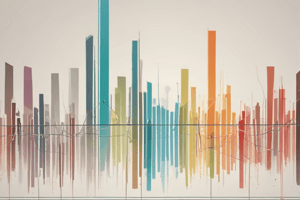Podcast
Questions and Answers
What is the purpose of a bar graph?
What is the purpose of a bar graph?
To compare values and make numerical relationships visible.
How are numerical data represented in bar graphs?
How are numerical data represented in bar graphs?
As rectangular bars aligned horizontally or vertically.
What do bar graphs excel at?
What do bar graphs excel at?
Comparing the relative values of different categories and identifying patterns or trends.
What are the two main types of bar graphs?
What are the two main types of bar graphs?
What is the main advantage of bar graphs mentioned in the text?
What is the main advantage of bar graphs mentioned in the text?
How do pictographs represent quantities?
How do pictographs represent quantities?
Who are pictographs particularly effective for communicating data to?
Who are pictographs particularly effective for communicating data to?
What is a limitation of pictographs mentioned in the text?
What is a limitation of pictographs mentioned in the text?
Why are bar graphs considered essential tools for visualizing and communicating data?
Why are bar graphs considered essential tools for visualizing and communicating data?
What is the particular strength of pictographs compared to bar graphs?
What is the particular strength of pictographs compared to bar graphs?
Flashcards are hidden until you start studying
Study Notes
Bar Graph and Pictograph: A Comprehensive Guide
In the realm of data visualization, bar graphs and pictographs are two popular methods for presenting quantitative information. Both formats offer unique advantages and applications, and we'll explore them in detail below.
Bar Graphs
Bar graphs are a common and straightforward way to compare values and make numerical relationships visible. Their simplicity and effectiveness make them popular in various contexts, including scientific research, education, and business.
How Bar Graphs Work
Bar graphs represent numerical data as rectangular bars aligned horizontally or vertically. Each bar corresponds to a specific category, and its height or length indicates the numerical value associated with that category.
For example, a horizontal bar graph might illustrate the number of books sold by different authors in a bookstore, with the x-axis representing authors and the y-axis representing the number of books sold.
Types of Bar Graphs
Bar graphs come in two main types:
- Horizontal Bar Graphs: Bars are arranged horizontally, and readers understand the data by comparing the lengths or heights of the individual bars.
- Vertical Bar Graphs: Bars are arranged vertically, allowing readers to compare data by observing the height of each bar.
Advantages of Bar Graphs
Bar graphs excel at comparing the relative values of different categories and making it easy to identify patterns or trends. They are versatile, suitable for displaying both discrete and continuous data. Furthermore, bar graphs are easy to interpret, even for people with little experience in data visualization.
Pictographs
Pictographs, also known as picture graphs, are a visual representation of numerical data using illustrations, symbols, or icons. They are often used to help readers understand and engage with data more readily.
How Pictographs Work
Pictographs use symbols or icons to represent quantities. For example, a pictograph illustrating the number of ice cream cones sold might use an ice cream cone icon, with the number of cones represented by a cluster of icons arranged in rows or columns.
Advantages of Pictographs
Pictographs are particularly effective for communicating data to a young audience or people with limited numerical literacy. They are also effective in capturing attention and conveying information in a fun, engaging way.
Limitations of Pictographs
While pictographs are a powerful tool for communicating data visually, they can sometimes be misleading or difficult to interpret. For example, if the size of an icon doesn't correspond directly to the quantity it represents, readers may struggle to understand the relationship between the symbols and the actual data.
In conclusion, bar graphs and pictographs are essential tools for visualizing and communicating data. While bar graphs offer a straightforward approach for comparing values and making numerical relationships visible, pictographs are particularly effective at engaging young audiences and communicating information in a fun, engaging way. Both formats have their advantages, and we should choose the appropriate visualization based on the audience, the data, and the intended message.
Studying That Suits You
Use AI to generate personalized quizzes and flashcards to suit your learning preferences.




